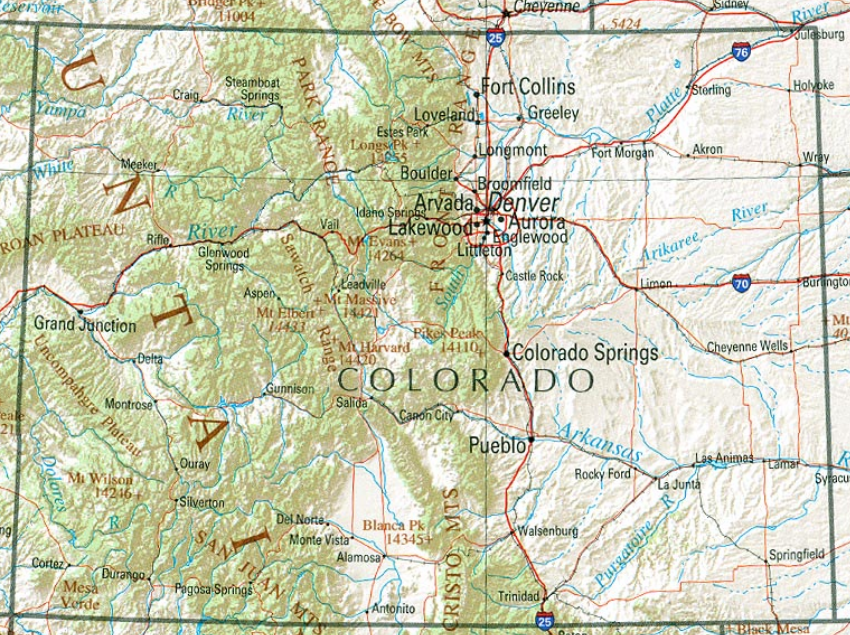After two years of public comment and revisions, Extraction will be allowed to drill in Broomfield–but will Colo. voters stop it in November with positive setback vote on 97?
Extraction Oil & Gas (ticker: XOG) got the news this week that its Comprehensive Drilling Plan (CDP), dated July 27, 2018, was conditionally approved by the City and County of Broomfield, a municipality in the northern Denver metro area on Colorado’s Front Range.
“After months of review and public comment, the City and County of Broomfield conditionally approved the Comprehensive Drilling Plan (CDP) with Extraction Oil and Gas on August 20, 2018,” Broomfield said in a press release.
The approval of the CDP marks the culmination of two years of efforts, including the appointment by the Mayor and City Council of an Oil and Gas Comprehensive Plan Task Force that resulted in recommendations for regulations that are more protective of health and the environment than state regulations, Broomfield said.
The CDP that was conditionally approved by the City and County Manager is made up of 23 separate plans, covering such topics as air quality, noise, emergency management, risk management, and detailed site plans. A copy of the approved CDP can be found here.
The Extraction CDP for six pad sites containing 84 wells.

In its letter to Extraction, Broomfield outlined the following conditions to the approval of its CDP:
- Extraction will place security guards at each of its Well Sites beginning no later than the Drilling Phase through the Completions Phase and amend the CDP accordingly.
- Extraction will place hay bales at locations determined by the City to protect the trees located in the Davis Open Space which provide important wildlife habitat and amend the CDP accordingly.
- Extraction will send mailers to the privately owned occupied structures south of the Northwest Parkway, north of 156th Avenue, west of Huron Street, east of the Zuni Street alignment, and immediately to the south of the Davis and Nordstrom Open Space as well as the three residents located at 15573, 15575, and 15585 Zuni Street regarding the final alignment of the access drive, at the sooner of, seven days prior to the start of construction of this access drive or, within thirty days of the date of this letter.
- Extraction will make payment to Mr. Baker to compensate him for his crops lost due to the construction of pipelines through property Mr. Baker leases from Broomfield, in an amount equal to $1,200 per acre of lost crops in 2018, within a time frame acceptable to Mr. Baker.
- Extraction will revise Attachment B to Section J – Response Preparedness Plan to add the following two items/agreements:
- The City will be constructing water lines and installing fire hydrants to locations closer to Extraction’s Well Sites. Extraction agrees that it will reimburse the City for the City’s actual costs for such construction and installation, not to exceed $400,000. Extraction will make such reimbursement to the City within thirty days of the City presenting Extraction with an executed contract for the work to be completed. Notwithstanding the foregoing, any failure by the City to make these improvements timely or not at all shall not serve to delay Extraction in any way.
- Extraction will pay for the items included on Attachment B to the Emergency Response Plan, Section J, rather than just providing them.
- The last sentence of the first section of the CDP, at page 20 under “6.0 Conclusion and next steps” will be amended to read: “Extraction and Broomfield agree to adopt any changes to the Plans as requested by either party after the CDP is approved, so long as such requests are reasonable, not in conflict with the Operator Agreement, and do not have material safety, economic, timing or other operational impacts.”
- In advance of well pad construction, Extraction shall complete baseline air quality and baseline noise testing for each of the four general drilling locations prior to commencement of pad construction, with the contractor, location, and method of such testing being subject to the reasonable approval by Broomfield, and Extraction will amend the CDP accordingly.
- A new sentence shall be added to Section 6.0, Conclusions and Next Steps, on page 20 of the CDP, to read as follows: Extraction will comply with all safety requirements of the CDP and implement any additional, reasonable, future measures needed to ensure safety.
- Extraction shall provide an amended Section (R) Risk Management Plan that includes the following additional risks, associated mitigation efforts, & resulting mitigated risk probability:
- Each safety related risks identified in Extraction’s Securities and Exchange Commission Form 10-K;
- Wildfire;
- Light pollution;
- Sabotage and vandalism;
- Risks associated with pipelines (see Operator Agreement, Ex. B, BMP #3); and
- Risks associated with potential interference with existing wells, including plugged and abandoned wells, during the fracking process. If Extraction believes such risks are already included in the Risk Management Plan, Extraction will provide specific cross references.
- Prior to the beginning of the Drilling Phase at any well site and subject to the approval of the City and County Manager, Extraction will provide the Risk Analysis, as referenced in the CDP in Section (W) Alternative Site Analysis, in sub-Section 7.5, and such Risk Analysis should support all of those critical risks identified in the Risk Management Plan.
- Per Section 36, Plugged & Decommissioned Well Testing of Exhibit B of the Operator Agreement, within 30 days of approval of the CDP the Operator shall provide Broomfield with a list of the wells that will have soil testing and the schedule for such testing.
- Final plans submitted by Extraction shall include all specifically listed requirements of Section 9(A) & (B) of the Operator Agreement.
- A provision should be added to the CDP that Extraction will notify its subcontractors of all relevant requirements and require all subcontractors to comply with the conditions of the Operator Agreement and the CDP.
- Add a provision to Section J – Response Preparedness Plan that any spill outside of the containment area, that has the potential to leave the facility or to threaten waters of the state, or as required by the City-approved Emergency Plan shall be reported to Broomfield as soon as possible, but no later than 24-hours, as referenced in Exhibit B of the Operator Agreement, BMP #19(C) and COGCC Rule 906.

Oil and gas wells have been located in Broomfield since the 1950s. Broomfield has been faced with oil and gas development at these or other nearby well sites since 2012, when Noble Energy first indicated its intent to drill.
State law: local governments are not allowed to prohibit drilling, fracing in Colorado
In its press release Broomfield pointed out that under the law of the State of Colorado, local governments cannot prohibit oil and gas development within their jurisdiction, nor can local governments prohibit hydraulic fracturing.
The Colorado Supreme Court has held that most aspects of oil and gas development are to be regulated by the Colorado Oil and Gas Conservation Commission (COGCC) and beyond the regulatory authority of local governments.
Since 2016, Broomfield has worked with Extraction, a citizen led task force, and the community, to put in place best management practices for the Extraction well pads that are among the most stringent in the State of Colorado.
City Council adopted the Oil and Gas Comprehensive Plan Task Force recommendations in August of 2017 and those robust requirements became the basis of Broomfield’s negotiations with Extraction and Broomfield’s updated oil and gas regulations.
Broomfield said its inspectors will be onsite and inspecting every stage of Extraction’s operations and pursue enforcement of the Operator Agreement and the CDP. Broomfield continues to make efforts to improve COGCC regulation of the oil and gas industry, including participation in the flowline rulemaking, forced pooling rulemaking, and potential upcoming financial assurance rulemaking.
Giving local governments the right to disallow drilling is part of the 2,500-foot setback ballot initiative, #97, now awaiting signature verification at Secretary of State’s office, then it would go on the ballot in November
Colorado ballot initiative 97, the proposed change to state statute–changing the law to impose mandatory 2,500-foot drilling setbacks around protected areas like rivers and water sources and all occupied structures, and give local governments their own power to impose bigger setbacks–may have taken a giant leap closer to becoming reality.
Secretary of State Wayne Williams’ office confirmed with Oil & Gas 360© via email that the petitions had been turned in, but the office would not report any numbers or any other details.
Macquarie Research reported in an equity research note that proponents of initiative 97 had turned in enough signatures, in the firm’s estimation, for the measure to make it to the November ballot. “We believe the Initiative is likely to make the November ballot,” Macquarie said in its note. “This is a large negative for Colorado names and one that creates a meaningful overhang until November.”
“The supporters are indicating they have turned in over 170,000+,” Macquarie said in the note. “The quick take away is we believe that Initiative 97 WILL likely pass the verification process based on the number of signatures submitted.”
Signature verification can take up to 30 days, according to the Secretary of State. The research group believes the verification process for 97 will likely take about three weeks. In 2016, setback proponents turned in signatures for a constitutional amendment requiring a 2,500-foot setback for oil and gas drilling, but the groups behind the initiative failed to garner enough verified signatures and the initiative failed to make the ballot.
Macquarie said it believes “that 130,000-150,000+ signatures are required to meet the threshold of 98,492 verified signatures. “We rely upon the Secretary of State’s initial estimate for our initial conclusion. Admittedly, there is some uncertainty in the number but we believe the market has not believed in this outcome and stocks will react negatively until proven otherwise.”
The statistical analysis of the signatures will look at a 5 percent random sample and test to confirm if needed number has been reached. If the extrapolated analysis demonstrates they would be below 90% of the 98,492 verified signatures, the initiative is denied. If it is above 110% of the 98,492 signatures, it is placed on the ballot (subject to appeals) and between 90% and 110% a full count is undertaken, Macquarie reported in the note.
In a separate press release, the Secretary of State said, “Today’s deadline was to turn in 98,492 valid voter signatures, which is 5 percent of the total votes cast for all candidates for Secretary of State in the 2014 general election. A random sample of signatures is then conducted.”
97 would change the existing law, not create a constitutional amendment
Since this year’s initiative 97 was put forth as a voter initiative to change Colorado statues, rather than to amend the constitution, only a simple majority of votes is required. The 2016 version of the setback initiative was put forward as a change, or amendment, to the Colorado constitution. That process became tougher after voters two years ago approved Amendment 71, which makes it more difficult to amend the constitution. In addition to requiring that signatures come from 2 percent of voters in each Senate district, the measure also required constitutional amendments to pass with a 55-percent majority rather than a simple majority.
Read prior coverage of 97 here.
What 97 would do to the oil and gas industry in Colorado
Initiative 97 would effectively stop most new drilling and development in the more densely populated areas of Colorado, including the Wattenberg field, by removing a huge percentage of surface area from drilling and development. The initiative would designate 2500-foot buffer zones around “occupied structures” and “vulnerable areas.”
The Colorado Oil and Gas Conservation Commission (COGCC), Colorado’s oil and gas regulator, has released acreage-reduction calculations based on a successful initiative 97, saying that of the 7 million acres of non-federal land in Colorado’s top oil and gas producing counties, proposed initiative #97 would exclude 6.5 million acres from drilling and development. That’s a 93% reduction in non-federal land available to drill. The number could go higher as the initiative provides for local municipalities to impose bigger setbacks to remove areas from availability for drilling as they see fit.
As of Aug. 23, three of five ballot signature petitions that were turned in on Aug. 6 have been verified to have enough signatures by the Secretary of State to land on the November ballot. The Secretary of State’s office told Oil & Gas 360 the ballot initiative petitions are verified in the order received. Signatures for 97 were among the final groups turned in.








